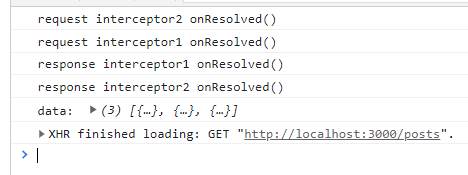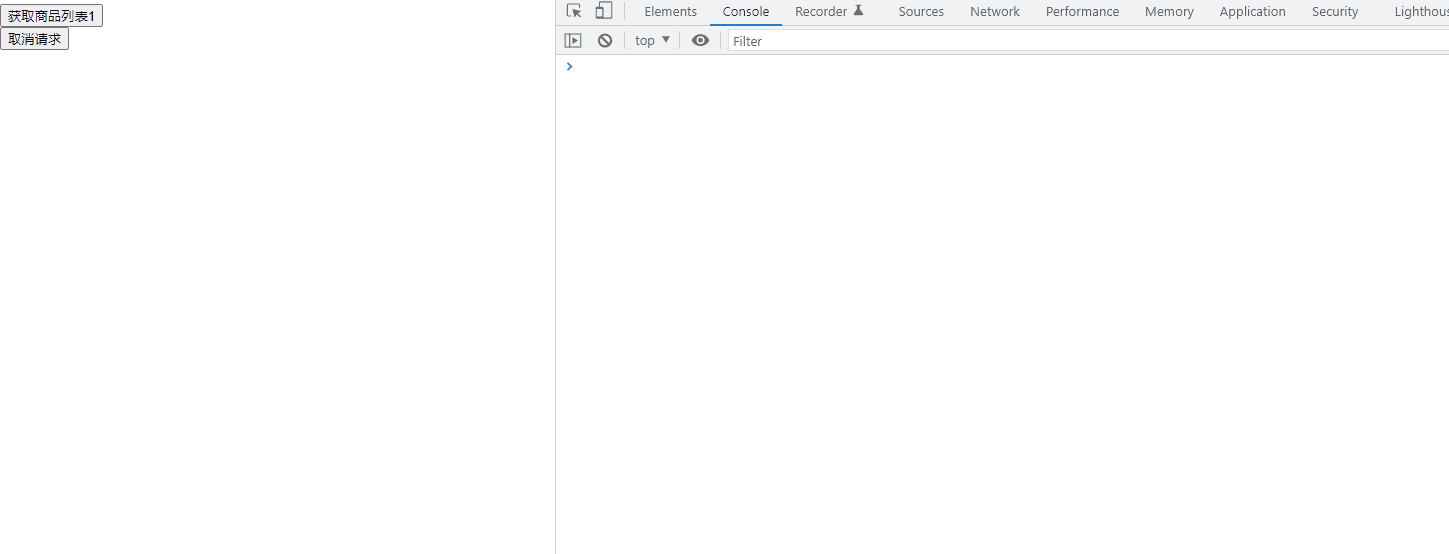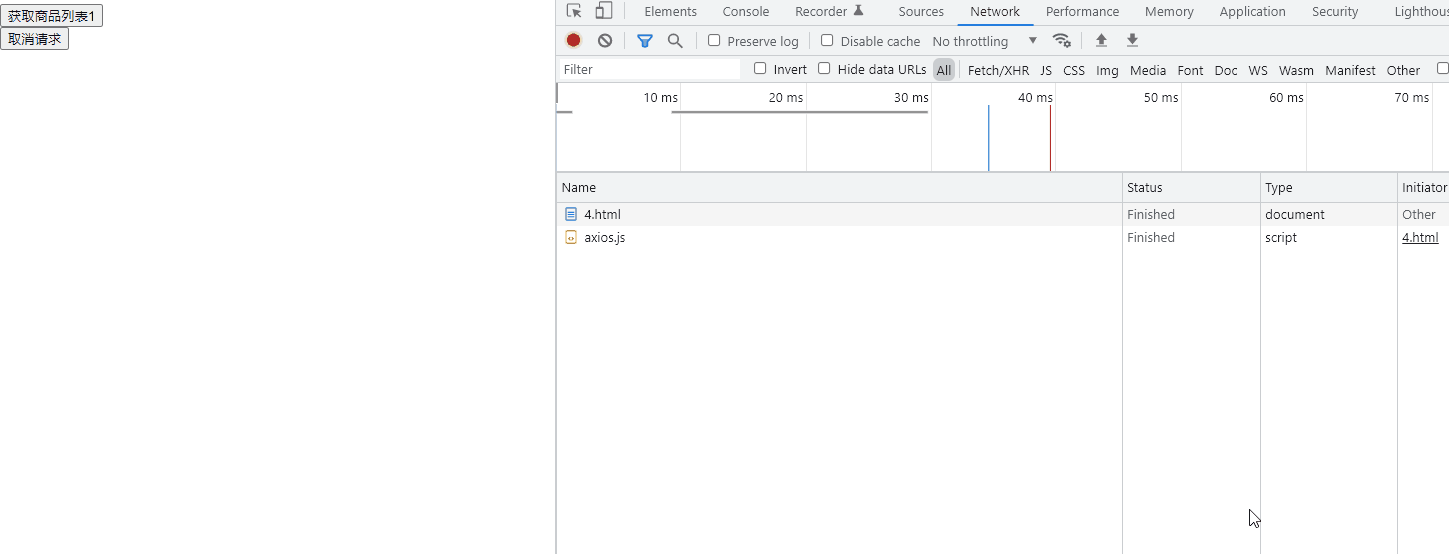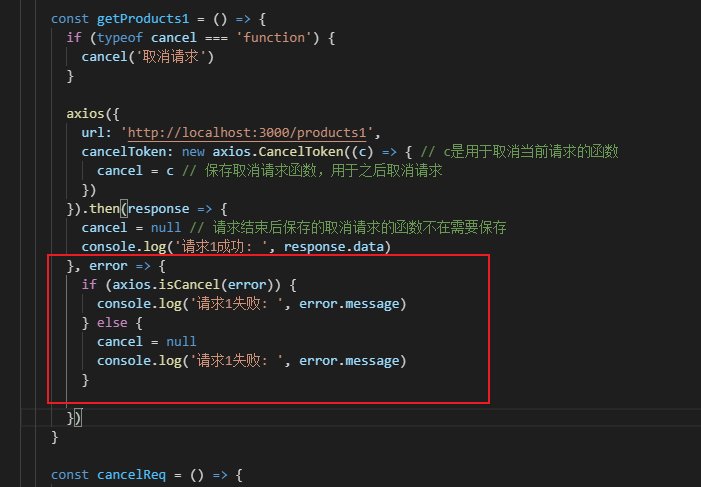axios 笔记(二) 深入了解 axios 1. 介绍
前端最流行的 ajax 请求库
react / vue 官方推荐使用 axios 发送 ajax 请求
axios 仓库
2. axios 特点
基于 promise 的异步 ajax 请求库
浏览器端 / node 端都可以使用
支持请求 / 响应拦截器
支持请求取消
请求 / 响应数据转换
批量发送多个请求
3. axios 常用语法
axios(config):最本质的能发任何类型请求的方式
axios.get(url, config):发 get 请求
axios.put(url, config):发 put 请求
axios.defaults.xxx:请求的默认全局配置,如 baseURL
axios.interceptors.request.use():添加请求拦截器
axios.interceptors.response.use():添加响应拦截器
axios.create(config):新建一个 axios 实例(没有以下的功能)
axios.Cancel():用于创建取消请求的错误对象
axios.CancelToken():用于创建取消请求的 token 对象
axios.isCancel():判断是否是一个取消请求的错误
axios.all(promises):用于批量执行多个异步错误
3.1 axios 简单使用 1 2 3 4 5 6 7 8 9 10 11 12 13 14 15 16 17 18 19 20 21 22 23 24 25 26 27 28 29 30 31 32 33 34 35 36 37 38 39 40 41 42 43 44 45 46 47 48 49 50 51 52 53 54 55 56 57 <!DOCTYPE html > <html lang ="en" > <head > <meta charset ="UTF-8" /> <meta http-equiv ="X-UA-Compatible" content ="IE=edge" /> <meta name ="viewport" content ="width=device-width, initial-scale=1.0" /> <title > Document</title > </head > <body > <button onclick ="testGet()" > GET请求</button > <button onclick ="testPost()" > POST请求</button > <script src ="./node_modules/axios/dist/axios.min.js" > </script > <script > axios.defaults .baseURL = "http://localhost:3000" ; const testGet = ( axios ({ url : "/posts" , method : "GET" , params : { id : 1 , }, }).then ( (response ) => { console .log (response); }, (error ) => { alert (error.message ); } ); }; const testPost = ( axios ({ url : "/posts" , method : "POST" , data : { title : "axios" , author : "clz" , }, }).then ( (response ) => { console .log (response); }, (error ) => { alert (error.message ); } ); }; </script > </body > </html >
3.2 axios.create(config) 简单使用
1 2 3 4 5 6 7 8 const instance1 = axios.create ({baseURL : "http://localhost:3000" ,instance1 ({url : "/posts" ,
可以发现用法和 axios()很像,和下面一样效果
1 2 3 4 axios.defaults .baseURL = "http://localhost:3000" ;axios ({url : "/posts" ,
那么,axios.create(config)肯定得有它的过人之处,否则,早就会被淘汰掉了。
先来一个情景:我们要向端口 3000 发送 get 请求,要向端口 4000 发送 post 请求
通过 axios.create(config)实现 :
1 2 3 4 5 6 7 8 9 10 11 12 13 14 15 16 17 18 const instance1 = axios.create ({baseURL : "http://localhost:3000" ,instance1 ({url : "/posts" ,const instance2 = axios.create ({baseURL : "http://localhost:4000" ,instance2 ({url : "/posts" ,method : "POST" ,
直接通过 axios()实现 :
1 2 3 4 5 6 7 8 9 10 axios.defaults .baseURL = "http://localhost:3000" ;axios ({url : "/posts" ,defaults .baseURL = "http://localhost:4000" ;axios ({url : "/posts" ,method : "POST" ,
可能有人会提出疑问:不是一样都能实现吗?但是,如果我需要最后在向端口 3000 再发送一次 GET 请求的话。
让我们再看一下代码:
通过 axios.create(config)实现 :
1 2 3 4 5 6 7 8 9 10 11 12 13 14 15 16 17 18 19 20 const instance1 = axios.create ({baseURL : "http://localhost:3000" ,instance1 ({url : "/posts" ,const instance2 = axios.create ({baseURL : "http://localhost:4000" ,instance2 ({url : "/posts" ,method : "POST" ,instance1 ({url : "/posts" ,
直接通过 axios()实现 :
1 2 3 4 5 6 7 8 9 10 11 12 13 14 15 axios.defaults .baseURL = "http://localhost:3000" ;axios ({url : "/posts" ,defaults .baseURL = "http://localhost:4000" ;axios ({url : "/posts" ,method : "POST" ,defaults .baseURL = "http://localhost:3000" ;axios ({url : "/posts" ,
比较上面的两种情况,就能发现**axios.create(config)的好处了。因为是新建 axios 实例,所以 3000 和 4000 两个端口分别使用的是不同的 axios 实例。所以能够很好地各司其责。而 axios()则不能,仅仅只是简单地修改 baseURL,都需要每次发送请求前重新修改,还是未考虑异步的情况。这么一看,在这种情况下, axios.create()**新建 axios 实例还是很香的。
3.3 拦截器及运行流程 3.3.1 添加请求拦截器 1 2 3 4 5 6 7 8 9 10 axios.interceptors .request .use (function (config ) {return config; function (error ) {return Promise .reject (error);
3.3.2 添加响应拦截器 1 2 3 4 5 6 7 8 9 10 11 12 axios.interceptors .response .use (function (response ) {return response;function (error ) {return Promise .reject (error);
3.3.3 拦截器简单使用 1 2 3 4 5 6 7 8 9 10 11 12 13 14 15 16 17 18 19 20 21 22 23 24 25 26 27 28 29 30 31 32 33 34 35 36 37 38 39 40 41 42 43 44 45 46 47 48 49 50 51 52 53 54 55 56 57 58 59 60 61 62 63 64 65 66 67 <!DOCTYPE html > <html lang ="en" > <head > <meta charset ="UTF-8" /> <meta http-equiv ="X-UA-Compatible" content ="IE=edge" /> <meta name ="viewport" content ="width=device-width, initial-scale=1.0" /> <title > 拦截器简单使用</title > </head > <body > <script src ="./node_modules/axios/dist/axios.min.js" > </script > <script > axios.interceptors .request .use ( (config ) => { console .log ("request interceptor1 onResolved()" ); return config; }, (error ) => { console .log ("request interceptor1 onRejected()" ); return Promise .reject (error); } ); axios.interceptors .request .use ( (config ) => { console .log ("request interceptor2 onResolved()" ); return config; }, (error ) => { console .log ("request interceptor2 onRejected()" ); return Promise .reject (error); } ); axios.interceptors .response .use ( (response ) => { console .log ("response interceptor1 onResolved()" ); return response; }, (error ) => { console .log ("response interceptor1 onRejected()" ); return Promise .reject (error); } ); axios.interceptors .response .use ( (response ) => { console .log ("response interceptor2 onResolved()" ); return response; }, (error ) => { console .log ("response interceptor2 onRejected()" ); return Promise .reject (error); } ); axios .get ("http://localhost:3000/posts" ) .then ((response ) => { console .log ("data: " , response.data ); }) .catch ((error ) => { console .log ("error: " , error.message ); }); </script > </body > </html >
先发送请求,再接收响应。所以会先触发请求拦截器,再触发响应拦截器,经过响应拦截器后才能得到数据
3.3.4 取消请求 express 知识:Express 笔记: clz
先搭建一个服务器:
1 2 3 4 5 6 7 8 9 10 11 12 13 14 15 16 17 18 19 20 21 22 23 const express = require ("express" );const cors = require ("cors" );const app = express ();use (cors ()); use (express.json ()); get ("/product1" , (req, res ) => {setTimeout (() => {send ([id : 1 ,name : "product1" ,2000 );listen (3000 , () => {console .log ("http://localhost:3000" );
开启服务器, node server.js或 nodemon server.js(支持热更新)
取消请求的简单使用 :
先定义一个变量 cancel,用于保存取消请求的函数
设置请求路径、请求方法时,还要设置属性 cancelToken,值为一个 CancelToken对象,CancelToken 类的构造函数的参数是用于请求的函数
1 2 3 4 cancelToken : new axios.CancelToken ((c ) => {
在需要请求的地方,调用保存的取消请求的函数
1 2 3 4 5 6 7 8 9 10 11 12 13 14 15 16 17 18 19 20 21 22 23 24 25 26 27 28 29 30 31 32 33 34 35 36 37 38 39 40 41 42 43 44 45 46 47 <!DOCTYPE html > <html lang ="en" > <head > <meta charset ="UTF-8" /> <meta http-equiv ="X-UA-Compatible" content ="IE=edge" /> <meta name ="viewport" content ="width=device-width, initial-scale=1.0" /> <title > 取消请求</title > </head > <body > <button onclick ="getProducts1()" > 获取商品列表1</button > <br /> <button onclick ="cancelReq()" > 取消请求</button > <script src ="./node_modules/axios/dist/axios.js" > </script > <script > let cancel; const getProducts1 = ( axios ({ url : "http://localhost:3000/products1" , cancelToken : new axios.CancelToken ((c ) => { cancel = c; }), }).then ( (response ) => { cancel = null ; console .log ("请求1成功: " , response.data ); }, (error ) => { cancel = null ; console .log ("请求1失败: " , error.message , error); } ); }; const cancelReq = ( if (typeof cancel === "function" ) { cancel ("强制取消请求1" ); } else { console .log ("没有可以取消的请求" ); } }; </script > </body > </html >
另外,取消请求的函数可以传参,传的参数将变成请求失败时,Cancel 对象的 message(这个时候并不是 Error 对象)
取消请求优化 :发送请求前取消掉未完成的请求
在点击事件最前面添加判断
1 2 3 if (typeof cancel === "function" ) {cancel ("取消请求" );
这里会出现一个问题,如果连续发送三个请求(在收到响应之前),会发现,第三个请求没有取消掉前一个未完成的请求
为什么会这样呢?看下下面的流程图就可能可以迎刃而解了(有错可评论指出)
为了解决上面的问题,这时候就需要使用 axios.isCancel(error)判断是不是取消请求导致的请求失败,如果是,则此时不需要把 cancel变为null
1 2 3 4 5 6 7 8 9 10 11 12 13 14 15 16 17 18 19 20 21 22 23 24 25 26 27 28 29 30 31 32 33 34 35 36 37 38 39 40 41 42 43 44 45 46 47 48 49 50 51 52 53 54 <!DOCTYPE html>
通过拦截器再优化 :增加代码可复用性
1 2 3 4 5 6 7 8 9 10 11 12 13 14 15 16 17 18 19 20 21 22 23 24 25 26 27 28 29 30 31 interceptors .request .use ((config ) => {if (typeof cancel === "function" ) {cancel ("取消请求" );cancelToken = new axios.CancelToken ((c ) => {return config;interceptors .response .use ((response ) => {null ;return response;(error ) => {if (axios.isCancel (error)) {console .log ("请求取消: " , error.message );return new Promise (() => {}); else {null ;return Promise .reject (error);
完整代码:
1 2 3 4 5 6 7 8 9 10 11 12 13 14 15 16 17 18 19 20 21 22 23 24 25 26 27 28 29 30 31 32 33 34 35 36 37 38 39 40 41 42 43 44 45 46 47 48 49 50 51 52 53 54 55 56 57 58 59 60 61 62 63 64 65 66 67 68 69 70 71 72 73 74 75 76 77 78 79 80 81 82 83 84 85 86 87 <!DOCTYPE html > <html lang ="en" > <head > <meta charset ="UTF-8" /> <meta http-equiv ="X-UA-Compatible" content ="IE=edge" /> <meta name ="viewport" content ="width=device-width, initial-scale=1.0" /> <title > 取消请求</title > </head > <body > <button onclick ="getProducts1()" > 获取商品列表1</button > <br /> <button onclick ="getProducts2()" > 获取商品列表2</button > <br /> <button onclick ="cancelReq()" > 取消请求</button > <script src ="./node_modules/axios/dist/axios.js" > </script > <script > axios.interceptors .request .use ((config ) => { if (typeof cancel === "function" ) { cancel ("取消请求" ); } config.cancelToken = new axios.CancelToken ((c ) => { cancel = c; }); return config; }); axios.interceptors .response .use ( (response ) => { cancel = null ; return response; }, (error ) => { if (axios.isCancel (error)) { console .log ("请求取消: " , error.message ); return new Promise (() => {}); } else { cancel = null ; return Promise .reject (error); } } ); let cancel; const getProducts1 = ( axios ({ url : "http://localhost:3000/products1" , }).then ( (response ) => { console .log ("请求1成功: " , response.data ); }, (error ) => { console .log ("请求1失败: " , error.message ); } ); }; const getProducts2 = ( axios ({ url : "http://localhost:3000/products1" , }).then ( (response ) => { console .log ("请求2成功: " , response.data ); }, (error ) => { console .log ("请求2失败: " , error.message ); } ); }; const cancelReq = ( if (typeof cancel === "function" ) { cancel ("强制取消请求1" ); } else { console .log ("没有可以取消的请求" ); } }; </script > </body > </html >









